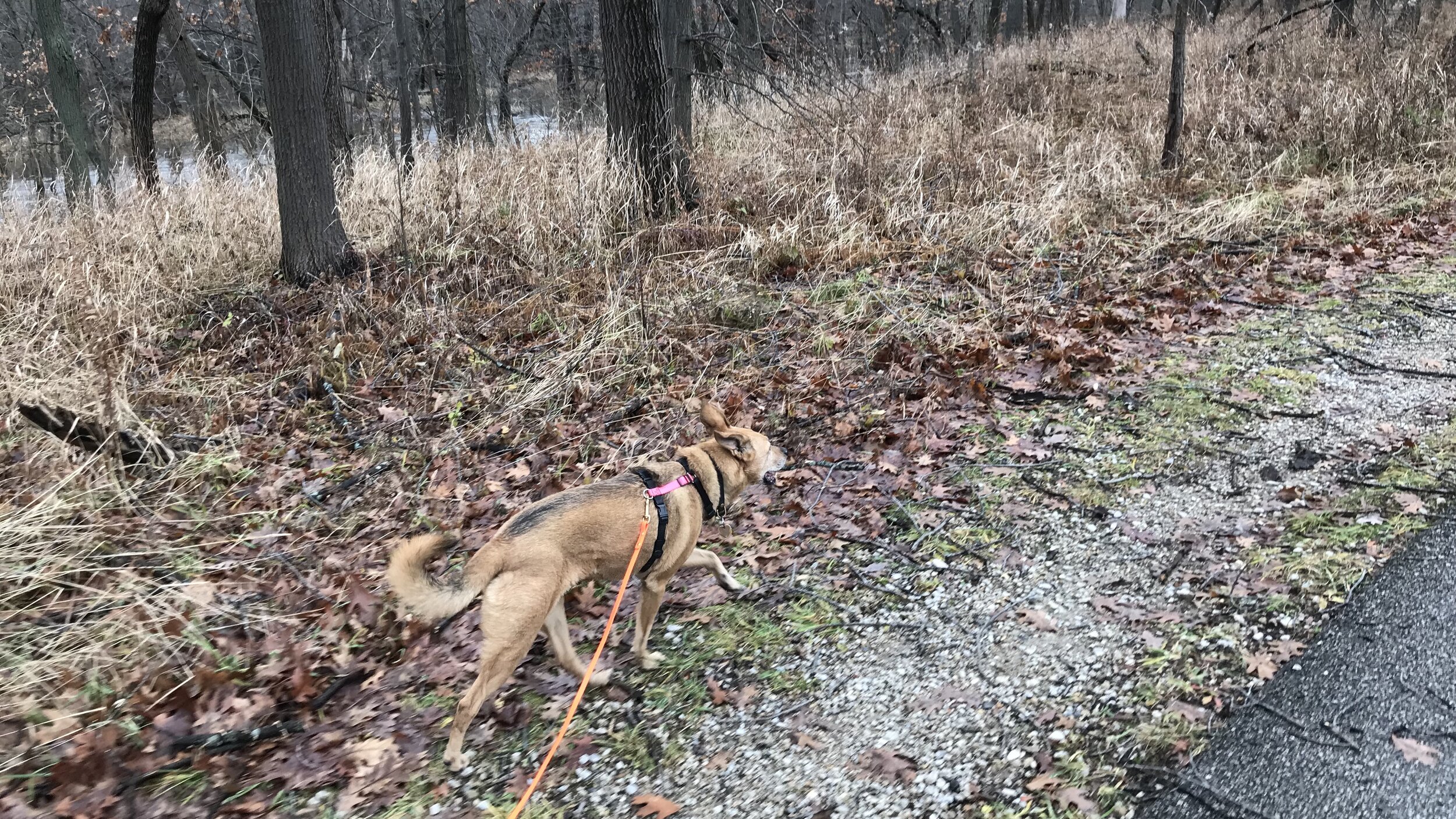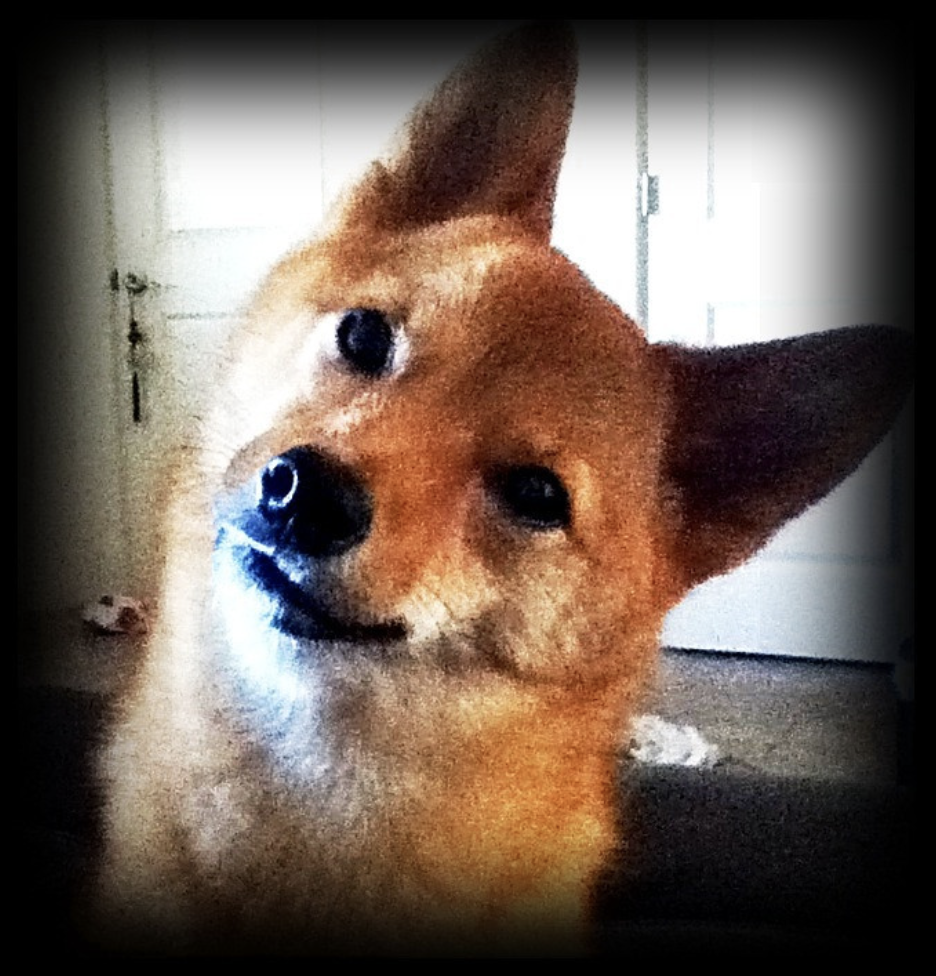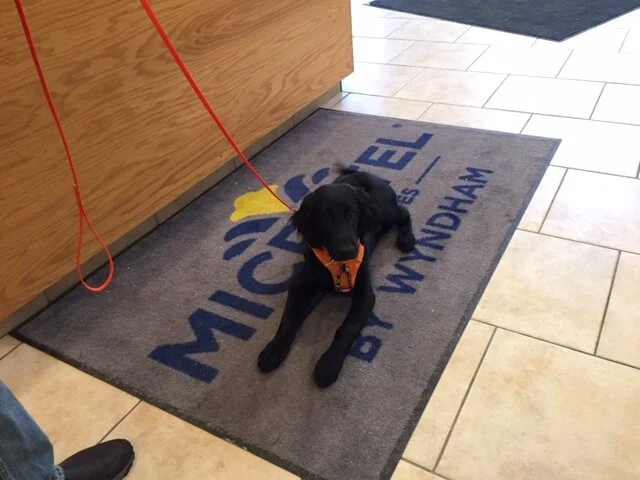There are many ways to teach a dog to walk on a leash, and I have tried a lot of them over the past 15 years, ranging from sharply yanking the dog’s collar every time she pulled (this was before I was even a student of dog training, and I don’t recommend it) through passively using various halters and harnesses to make pulling uncomfortable or counterproductive to clicking and treating when the leash was slack.
As I’ve learned more about both dogs and behavior, it has become apparent that "loose leash walking" is really a complex set of interactions between the dog, the handler, and the world--not a single or simple behavior.
How I teach it has evolved accordingly, some of it relatively recently, and I'm sure it will continue to do so. But here are what I currently think are some of the key pieces. Note that no one by itself is a magic solution (though sometimes the first one can seem like it). Some set the stage for others to work, and they are ideally implemented together.
Use a longer leash.
I was pleased to see this article yesterday about a study by two French trainers who found that dogs sniffed more on longer leashes, and that as they sniffed, their heart rate slowed. Here's their own report. It's cool way to try to measure what many dog trainers have observed more anecdotally, which is that giving dogs more control over their walks appears to have positive effects on their emotional behavior. Alexandra Horowitz’s canine cognition lab at Barnard has also published peer-reviewed research showing a connection between nosework and behaviors interpreted as “optimistic.”
What I want to suggest here, though, is that giving dogs more room to roam and sniff on walks may also have positive effects on their walking behavior.
When we attach dogs to a 6-foot rope and march them down the middle of a sidewalk, 8-10 feet from what they find interesting, we are setting them up to learn to pull. Basically, we tempt them with treasure just out of reach, and then when they hit the end of the leash on the way there, they learn that a little extra oomph will get them closer. For some dogs, a strain-and-sniff on a tight leash, even on a painful collar, even with an owner barking orders at their back, is still worth it.
So, how long a leash do you need? Maybe just longer than what you are using now, but not so long that you don’t feel comfortable or safe. Just a foot or two can make a difference for some; if you have a 6-foot leash but currently carry it gathered up or knotted, try just using all 6 feet. My personal preference is for a thin, flat biothane (like the one in the picture up top) leash somewhere between 8 and 15 feet long, depending on where I'm walking. I generally prefer nonrestrictive harnesses, like the Balance or Ruffwear harnesses, over collars, but the longer the line the more important it is that it is attached to the back clip of a harness, and not a collar or the front clip of a “no pull” harness like the Easy Walk. (Also note: retractable leashes don't work for this, because when they are extended, they are always taut.)
For puppies, I think a longer leash is especially beneficial. Their developmentally appropriate and necessary exploration can quickly become pulling when you add a short leash, and the ensuing struggle can put a early dent in the relationship between person and puppy. I've been lucky in recent years to have access to a few puppies over extended periods of time, and what I've seen so far is that as they learn about the world on a longer leash, get a lot of treats for checking in, develop a broader responsive relationship with their owner, and maybe just get a little older, they start to wander less and walk closer.
Even for older dogs who seem to be way more interested in access to the environment than any food, toy, or attention you have to offer, using a longer leash often seems to make walks less of a battle and can help the dog learn that pulling is not the only way to get those reinforcers. The dog may in fact be able to get enough of them on a long line that they become slightly less important, opening the door for you to use things like food or toys to teach more attentive behavior.
In short, by allowing dogs more free access up front to environmental reinforcers, we may be able to lower the value of those reinforcers through satiation (a move known in behavior analysis as an abolishing operation), and thus make pulling less likely.
We can also avoid reinforcing pulling, because the dog doesn't need to pull to get to those reinforcers. Instead those reinforcers may strengthen whatever he does instead. And we can minimize or avoid punishment, which may create other problems, because we aren't putting ourselves in a position where we have to react to a dog who is already pulling.
Using a longer leash doesn’t mean that the dog should be allowed to run up to anyone and anything. There are of course times when you need to keep your dog close to you, and if you don't want your adult dog to run up to everyone, you shouldn't teach her to do it as a puppy. But you can shorten a long line, and teach the dog what she should do instead when she can't reach something of interest. You can’t, however, lengthen a short line when it's OK to explore.
There may also be some situations, e.g., where a dog is a threat to people or other animals, in which a longer leash may not be appropriate—at least not immediately, without professional guidance and extra safety precautions. But these dogs, too, often benefit from being carefully given more leeway in their movement through the world. If you were worried about your surroundings, would you feel better or worse if you were routinely walked through them on a short, tight leash? Close restraint limits the behavioral options a dog has if she wants to escape or avoid something; if you can't flee in those circumstances, you are more likely to fight. This problem, where you need to control the dog for safety but restraint makes the situation worse, might mean you choose to walk where you don't need to restrain, and/or that you need additional intervention for the problem behavior.
However long it is, try to keep the leash slack.
When dogs continue to pull on a tight leash, it is often attributed to the probably misnamed “opposition reflex.”
But it may be more useful to think about how a tight leash can become a cue for pulling or other voluntary behaviors--the very behaviors you are probably trying to prevent when you tighten the leash.
Let’s say the dog is pulling toward something she wants to smell, and feels tension on the leash. She then pulls harder, and gains a bit more access to that smell. Or as the dog is pulling toward a person, the owner pulls back, lifting the dog and making it easier to stand on hind legs than on all fours; the person then walks forward and the dog gets petted while jumping. Or a dog sees a threatening dog, the owner tightens the leash, the dog barks and lunges, and then the other dog goes away. Things that routinely happen just before a behavior is reinforced--in all these cases, the leash tightening--can come to evoke that behavior in the future. You already know this if you have ever intentionally “captured” a behavior, using a clicker and treats, and then added the desired cue by saying it just before you know that the dog is about to offer the behavior again.
Keeping a leash slack does not require jogging to keep up with the dog or letting the leash spool out longer than is safe or appropriate in a given setting. Light-handed but effective leash management is a set of skills that can be broken down into steps and learned by handlers. A key component of Grisha Stewart’s BAT technique, for instance, is the skilled use of a long leash, and she does a great job breaking those skills down. Two moves I like to pre-teach are a “gather,” in which the owner learns to shorten a leash quickly and efficiently without adding (much) tension to it, and a “dip,” in which tension on the leash becomes a cue for the human to lower her hands, removing tension without adding (much) length. I additionally like to pre-teach the dogs that both of these moves are cues for their behavior: if I do one or both of those things, I want the dog to orient to me, because I’m probably getting ready to do something that will be easier if the dog is paying attention.
I teach both by doing the move, then immediately (and initially regardless of the dog's behavior), clicking and treating close to my body. Eventually when the dog feels or sees you doing the thing, he will orient toward you before you even have a chance to click; at that point, the move has started to become a cue.
Reinforce behavior, not products of behavior.
A common piece of advice in teaching loose leash walking is to reinforce “when the leash is loose.” But what is the dog actually doing to keep the leash loose? You can shape up some really odd behavior when you focus on the end product. Put in human terms, do you want to reinforce good test scores, or do you want to reinforce answering questions correctly and all the prerequisite behaviors needed to do that? Pick the former and you may reinforce cheating or guessing.
Teach prerequisite skills.
OK, then what behaviors do you need to teach your dog to do in order to have a nice outing with you on leash? My ideal end product looks like the dog meandering calmly (as in, not zipping across my path unexepctedly) on whatever length of leash is appropriate for the situation, sniffing whatever he likes (within safety parameters), checking in with me frequently, and trotting within 3-6 feet of me on a slack leash when not otherwise occupied; I don't really care which side, but I feed a lot on the right so usually that becomes the default. I also like to be able to cue a short-term close-walking behavior if needed.
Your ideal picture may be different from mine, but whatever pieces there are to it, identify them and teach them in low distraction, so both you and the dog can get fluent before there are lots of other things competing for your attention.
Here are my biggies:
- Looking at me voluntarily produces good stuff, here, there, anywhere, in a house, with a mouse. Start at home, but then green-eggs-and-ham that shit. If a dog likes to look at you a lot, when he's not otherwise occupied, he'll probably hang out in a position that lets him look at you easily. Start teaching this for the first time with your new longer leash attached, so that the leash can help tell the dog this game is on.
- Trotting next to me on cue. Reinforce for looking at you from close to your side a few times, then move. The dog will likely move alongside so he can get in position to look at you again, and you can reinforce the movement. You can then add a verbal or visual cue to ask for this behavior when you need it.
- The dip and the gather are cues to look at me (described in a previous section).
- What to do when I stop. When I slow down, as when coming within about 10-15 feet of a blind corner or a curb, I start to gather the leash. If I've taught that as a cue, the dog will start to pay attention, and if I want (and have taught these skills), I can cue him to sit or wait. For turning your own stopping into a cue for the dog to do something particular, see this older post.
- What to do if the leash goes tight: No matter how hard you both try to do what you're supposed to do, there will likely still be times when the dog ends up on a tight leash. Like most trainers of any stripe, I don’t go forward on a tight leash. The dog may feel tension if I start to slow down and he's not paying attention at that moment. Or you may not be able to completely break your own old habits (a scenario that should engender some empathy for your dog, who's been reinforced for pulling for years). For instance, if I see, too late that a dog is about to encounter something she simply can’t explore--chicken bones, synthetic marijuana, a person who did not ask to be explored, or . . . Jesus, is that what's left of a rat?--I’m going to put on the brakes. Even if I know intellectually that the dog has a strong response to "leave it" or "drop," I will probably still tighten the leash. I might then “dip” the leash--but sometimes I might not, say, if even a few inches will mean the dog could reach the booty.
So what should the dog do when that tension continues? As with the dip and the gather, I want to teach that ahead of time, and I want it to be an opportunity, not just an annoyance--a cue for the dog to turn away from the thing and get something potentially greater than what he leaves behind. I teach this more or less the same way I teach the dip and the gather, by having the smallest possible amount of tension predict a treat behind the dog until the tension begins to cue the dog to look for the treat. Start with mild or no distractions at all, not around flattened rat carcasses.
- What to do after checking out a "distraction": The innovative trainer Leslie McDevitt has worked out lots of fun and effective "pattern" games for teaching dogs heavily practiced sequences where conclusion of one behavior (e.g., sniffing) becomes a cue to do the next (e.g., checking in with the owner). Your preferences may differ, but in my book the dog checking out stuff (without needing to pull to get to it), and then checking back in, rather than shooting forward to the next thing he wants to investigate, is a very pleasant pattern for both of us. Again, you should teach these patterns in an easy setting first, before taking them on the road.
Deliver treats (and other reinforcers) with purpose.
Ideally, the delivery is timed so that it catches the dog in a behavior you want to see more of (say, trotting next to you with head forward), and also sets him up to do the next movement you want to see (be it continuing to move forward in the same position, or taking a sniff break). I can’t say I never screw this up, but I don’t want the timing to reinforce, or the position to set up, awkward behavior like walking down the street with neck craned backward to look at me. I most commonly deliver treats in two places on walks: next to my hip on the side I want the dog to default to when he walks close (Hannah Branigan calls this the “takeout window”) or out in the grass slightly ahead of the dog. But considerations include where the dog currently is (if he’s next to me and I want that to continue, the treat will appear in front of his nose) and where I want him next (if I want him to learn that sniffing is part of the reinforcer for checking in, I’ll toss the treat where he can continue walking forward to gather it and then also sniff).
UPDATE: Here’s video (jerky screen captures of FaceTime during the COVID-19 shutdown, sorry) of treat delivery with purpose: The grass is full of smells that are powerful reinforcers for Booker, so in tossing each treat back out into the grass, the goal is to double the reinforcement for catching up and checking in: a treat plus a return to the grass. The treat placement also sets Booker up to “catch up” easily. And of course the longer leash lets Booker sniff without setting him up to learn that pulling is worth it. In the second video, Jerry is increasing the amount of walking nearby required to get the treat, still tossed into the grass:
General rules for good training apply.
There are any number of other arrangements that might be important depending on the dog and the situation. Some might involve what to do when novel distractions appear (see this older blog post about teaching the dog what to do instead of running toward them). Most would apply to training any skill. For instance: start new skills in lower distraction settings; the dog gets to decide what is reinforcing; what she finds reinforcing will change depending on what else is available; reinforcement should be plentiful when learning new skills; and new skills should be broken down down into small achievable steps.
Note that's skills, plural. Most helpful in my thinking about walking has been this realization, that loose leash walking is a set of skills, for both handler and dog, that will need to be perpetually combined and recombined while navigating the world. Once we break down and teach these skills, we can also practice the ways in which they might intertwine.





